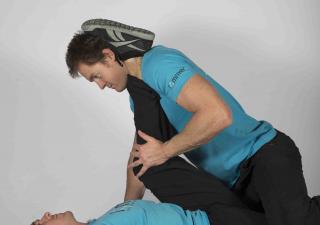In the first post in this series (Improving Athletic Performance Through PNF Stretching Part 1) we covered the mechanics of muscle and how the length and strength of a muscle are related. In this, we deal with how to perform PNF stretching to maximise performance.
PNF stretching is most commonly completed in a partner assisted setting – with the process almost requiring that this is so. It is possible however to complete PNF without the use of a practitioner while still gaining considerable results.
There are five stages in PNF:
- Static stretch.
- Antagonist contraction (opposite muscle to the one being stretched).
- Static stretch.
- Agonist contraction (the muscle being stretched).
- Static stretch.
We discuss each of these four stages, using a hamstring stretch as an example.
Stage One: Static stretch.
Gradual relaxation of the muscle. Hold for 10 seconds.
Stage Two: Antagonist contraction.
How to do it:
In this stage, the subject contracts the muscle that has the opposite action to the muscle being stretched. In our example, when stretching the hamstrings, the muscles involved in flexing the hip (the quadriceps and hip flexor musculature) are activated, causing the leg to flex at the hip and the hamstrings to be placed in a lengthened state. Hold for 10 seconds.
How it works:
This works due to a fancy sounding phenomenon called ‘Reciprocal Inhibition’. Basically, this tells us that when a muscle contracts, the opposite muscle relaxes. If the opposite muscle didn’t relax – the resulting co-contraction of the muscles around a joint would make any movement impossible. Reciprocal Inhibition allows efficient movement. Reciprocal = opposite. Inhibition = turns off. When the quadriceps and hip flexor musculature contract, the opposite muscle group (the hamstrings) turns off.
Stage Three: Static Stretch.
This allows for the relaxation of the muscle and for the change in length to take effect. Hold for 10 seconds.
Stage Four: Agonist Contraction.
How to do it:
In this stage you are contracting the muscle that is being stretched. As the muscle is being stretched you are basically fighting the stretch. In our example, while the hamstring is being stretched you are contracting the hamstrings to try and push the leg out of the stretch. Hold for 10 seconds.
How it works:
This works by addressing structures in your body that detect muscle movement, force and position, called Golgi Tendon Organs. When a muscle is contracted for a sustained period, these Golgi Tendon Organs cause the muscle to relax, allowing for an increase in muscle length.
Stage Five: Static Stretch.
This allows for the relaxation of the muscle and for the change in length to take effect. Hold for 10 seconds.
PNF works. It really works. Try these techniques and you’ll never go back to standard static stretching.





